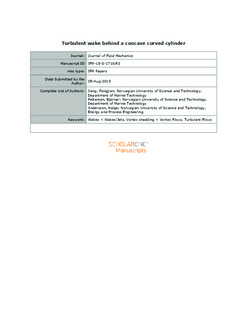| dc.contributor.author | Jiang, Fengjian | |
| dc.contributor.author | Pettersen, Bjørnar | |
| dc.contributor.author | Andersson, Helge Ingolf | |
| dc.date.accessioned | 2019-09-23T07:47:33Z | |
| dc.date.available | 2019-09-23T07:47:33Z | |
| dc.date.created | 2019-09-18T15:11:44Z | |
| dc.date.issued | 2019 | |
| dc.identifier.citation | Journal of Fluid Mechanics. 2019, 878 663-699. | nb_NO |
| dc.identifier.issn | 0022-1120 | |
| dc.identifier.uri | http://hdl.handle.net/11250/2618146 | |
| dc.description.abstract | We present a detailed study of the turbulent wake behind a quarter-of-ring curved cylinder at Reynolds number Re = 3900 (based on cylinder diamter and incoming ow velocity), by means of Direct Numerical Simulation (DNS). The con guration is referred to as a concave curved cylinder with incoming ow aligned with the plane of curvature and towards the inner face of the cylinder. Wake ows behind this con guration are known to be complex, but have so far only been studied at low Re. This is the rst DNS investigation of the turbulent wake behind the concave con guration, from which we reveal new and interesting wake dynamics, and present in-depth physical interpretations. Similar as in the low-Re cases, the turbulent wake behind a concave curved cylinder is a multi-regime and multi-frequency ow. However, in addition to the co-existing ow regimes reported at lower Re, we observe a new transitional ow regime at Re = 3900. The ow eld in this transitional regime is not dominated by von K arm an-type vortex shedding, but by periodic asymmetric helical vortices. Such vortex pairs exist also in some other wake ows, but are then non-periodic. Inspections reveal that the periodic motion of the asymmetric helical vortices is induced by vortex shedding in its neighboring oblique shedding regime. The oblique shedding regime is in turn in uenced by the transitional regime, resulting in a uni ed and remarkably low dominating frequency in both ow regimes. Due to this synchronized frequency, the new wake dynamics in the transitional regime might easily be overlooked. In the near-wake, two distinct peaks are observed in the time-averaged axial velocity distribution along the curved cylinder span, while only one peak was observed at lower Re. The presence of the additional peak is ascribed to a strong favorable base pressure gradient along the cylinder span. It is noteworthy that the axially-directed base ow exceeded the incoming velocity behind a substantial part of the quarter-of-ring and even persisted upwards along the straight vertical extension. As a by-product of our study, we nd that a straight vertical extension of 16 cylinder diameters is required in order to avoid any adverse e ects from the upper boundary of the ow domain. | nb_NO |
| dc.language.iso | eng | nb_NO |
| dc.publisher | Cambridge University Press | nb_NO |
| dc.title | Turbulent wake behind a concave curved cylinder | nb_NO |
| dc.type | Journal article | nb_NO |
| dc.type | Peer reviewed | nb_NO |
| dc.description.version | acceptedVersion | nb_NO |
| dc.source.pagenumber | 663-699 | nb_NO |
| dc.source.volume | 878 | nb_NO |
| dc.source.journal | Journal of Fluid Mechanics | nb_NO |
| dc.identifier.doi | 10.1017/jfm.2019.648 | |
| dc.identifier.cristin | 1726337 | |
| dc.description.localcode | © 2019. This is the authors’ accepted and refereed manuscript to the article. Locked until 18.3.2020 due to copyright restrictions. | nb_NO |
| cristin.unitcode | 194,64,20,0 | |
| cristin.unitcode | 194,64,25,0 | |
| cristin.unitname | Institutt for marin teknikk | |
| cristin.unitname | Institutt for energi- og prosessteknikk | |
| cristin.ispublished | true | |
| cristin.qualitycode | 2 | |
